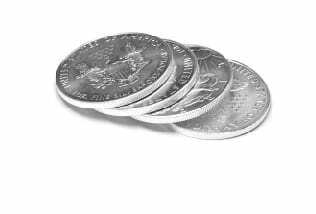Silver – that precious, shiny white metal – has traditionally been highly prized for its symbolism of wealth and prestige and its associated use in jewellery and coins. However, silver is currently much more commonly used for industrial, medical and electrical purposes, such as in household goods, solar panels and mobile phones.
Rare and valuable, silver is highly coveted because it resists corrosion and oxidation, it is the best thermal and electrical conductor of all metals and it is antimicrobial and non-toxic.
And talk about versatile – silver can be ground into powder, paste, shaved into flakes, converted into salt, alloyed with other metals, flattened into printable sheets, drawn into wires and more.
Here are some popular silver uses:
- Eclectic electric: Small quantities of silver are used in electrical switches, plasma TVs, light emitting diodes (LED) and DVDs and CDs have a thin, silver recording layer. Another interesting electronic application of silver is in batteries that employ silver oxide or silver zinc alloys. And electronics demand silver of the highest purity: 99.99 per cent pure, also known as having a fineness of 999.9. But wait, there’s more – dissolving pure silver in nitric acid produces silver nitrate, which can be formed into powder or flakes. This material can be fabricated into contacts or silver pastes, which has many uses – such as the rear defrost in many cars, in electronics, circuit paths and in photovoltaic cells for the production of solar energy. Nanosilver, silver with an extremely small particle size, provides a new frontier for technological innovation as it requires much smaller amounts of silver to get the job done.
2. Hot and cold: Brazing and soldering make excellent use of silver’s high tensile strength and ductility to create joints between two metal pieces. Brazing takes place at temperatures above 600C, while soldering takes place at temperatures below 600C. Silver scrap can be used in brazing and soldering because these processes do not require very pure silver. Brazing and soldering produce tight joints for everything from heating and air-conditioning vents to plumbing. And silver’s antibacterial properties and non-toxicity make it a great replacement for lead-based bonds between water pipes.
3. Chemical reaction: Silver acts as a catalyst to produce two important chemicals: ethylene oxide and formaldehyde. Ethylene oxide is used to produce moulded plastics like plastic handles and flexible plastics, such as polyester. It is also a major ingredient in antifreeze. As a catalyst, silver increases the speed of reactions without getting used up. Now, that’s clever!

4. My precious: Along with gold, silver has long been used as a precious metal in coins. In the past, people accumulated their wealth in the form of silver coins. Today, people covet investment-grade, pure silver bullion bars, coins or medallions. The fact that silver does not corrode and only melts at a relatively high temperature, not to mention its attractive lustre and malleability, results in this multipurpose metal being commonly used for designing and minting local currency. Many people also choose to invest in silver through financial tools, such as stocks and mutual funds.
5. Shiny art: Silver jewellery and silverware are still popular today due to the precious metal’s malleability, reflectivity and shiny lustre. However, because silver is so soft, it must be alloyed with base metals like copper, as in the case of sterling silver, which is made up of 92.5 per cent silver and 7.5 per cent copper. Less expensive than gold, silver is also a fashionable choice for fine dining dishes, plates and accompanying silverware – and these can often be ornately crafted works of art.

